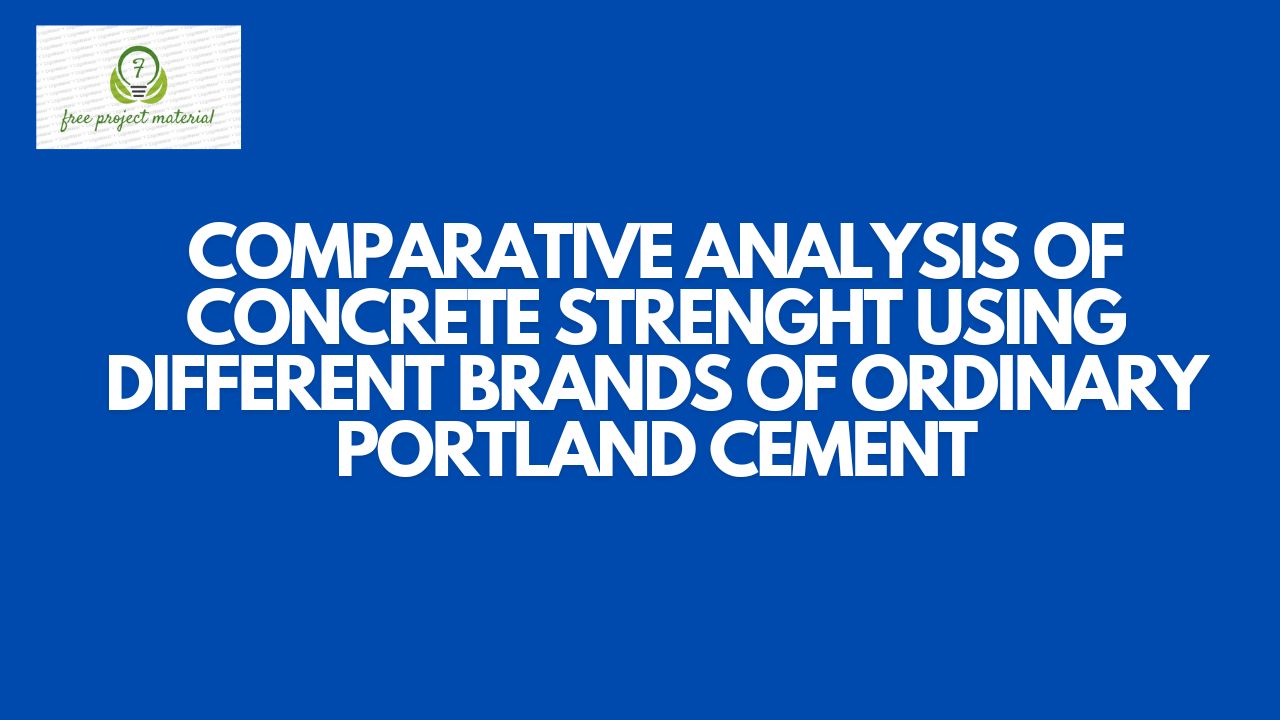ABSTRACT
This study comprises quality of different Brands of Ordinary Portland Cement (OPC).Three brands of Portland cement commonly available in Nigeria were investigated through series of tests conducted to determine their strength characteristics, setting time, soundness, workability and fineness among others and examine if they meet the minimum standard as stipulated by the British Standard Institute. Three brands of cement considered were Brand A, Brand B and Brand C. The strength characteristics of these three brands are similar with slight difference recorded. Dangote cement has the highest strength at 28th days curing period of 22.49 N/mm2 as the Crushing load while the least strength was Unicem at 22.49 N/mm2 as the crushing load.
TABLE OF CONTENTS
Title Page – – – – – – – – i
Certification – – – – – – – ii
Dedication – – – – – – – – iii
Acknowledgments – – – – – – iv
Abstract – – – – – – – – v
Table of Contents – – – – – – – vi-ix
CHAPTER ONE
1.0 INTRODUCTION – – – – – 1
1.1 Background of the Study – – – – 1-2
1.2 Problem Statement – – – – – 2
1.3 Aims and Objectives – – – – – 2-3
1.4 Significance of the Study – – – – 3
1.5 Limitation of the Study – – – – – 3-4
1.6 Scope of Study – – – – – – 4
1.7 Definition of Terms – – – – – 4-5
CHAPTER TWO
2.0 LITERATURE REVIEW- – – – – 6
2.1 Introduction – – – – – – 6
2.2 Compressive Strength of Concrete – – – 6-7
2.2.1 Concrete PSI – – – – – – 7-8
2.2.2 Strength Test of Concrete – – – – 8
2.2.3 Compressive Strength of Different Grades of
Concrete at 7 And 28 Days – – – – 8-9
2.3 Type of Strength in Concrete – – – – 9-10
2.4 Factors Affecting the Strength of Concrete – 10-11
2.5 Concrete Constituent Material- – – – – 12
2.5.1 Cement – – – – – – – 12-13
2.5.2 Aggregates – – – – – – – 13
2.6 Following Characteristic of Aggregate Affect
the Strength of Concrete – – – – – 13-14
2.7 Water Absorption – – – – – – 14-15
2.8 Normal Density and No-Fines Concrete – 15-18
CHAPTER THREE
3.0 MATERIALS AND METHODS- – – – 19
3.1 Materials – – – – – – – 19
3.2 Methods – – – – – – – 20
3.2.1 Batching by Weight – – – – – 20
3.2.2 Slump Test – – – – – – – 21
3.2.3 Densities of the Concrete – – – – 21
3.2.4 Crushing Loads of the Concrete Cubes – – 21-22
3.2.5 Compressive Strength of the Concrete Cubes – 22
CHAPTER FOUR
4.0 PRESENTATION AND DISCUSSION OF RESULTS
4.1 Presentation of Results – – – – – 23
4.2 Batching of the Concrete Constituent – – 23
4.3 Slump Result – – – – – – 24
4.4 Densities of the Concrete Cubes – – – 25-27
4.5 Compressive Strength of the Concrete – – – 28-30
4.6 Discussion of Results – – – – – 31
CHAPTER FIVE
CONCLUSION AND RECOMMENDATION
5.1 Conclusion – – – – – – – 32
5.2 Recommendation – – – – – – 32-33
References
LIST OF TABLES
Table 2.2.3: Compressive Strength of Different Grades
of Concrete at 7 and 28 Days – – – – 8-9
Table 4.1: Batching for Dangote Cement (A) – – 23
Table 4.2: Slump Test Results – – – – – 24
Table 4.3: Densities of the Concrete cubes for Brand A – 25
Table 4.4: Densities of the Concrete cubes for Brand B – 26
Table 4.5: Densities of the Concrete cubes of Brand C – 27
Table 4.6: Compressive strength of the Concrete
cubes for Brand A – – – – – 28
Table 4.7: Compressive Strength of the Concrete cubes
for Brand B – – – – – – – 29
Table 4.8: Compressive Strength of the Concrete
cubes of Brand C – – – – – – 30
CHAPTER ONE
1.0 INTRODUCTION
1.1 BACKGROUND OF THE STUDY
Compressive strength of concrete is the strength of hardened concrete measured by the compression test. The compression strength of concrete is a measure of the concrete’s ability to resist loads which tend to compress it. It is measured by crushed cylindrical concrete specimens. In compression testing machine compressive strength of concrete is determined in batching plant laboratories for every batch in order to maintain the desired quality of concrete during casting. The strength of concrete is required to calculate the strength of the members. Concrete specimens are a cast and testing under action of compressive loads to determine the strength of concrete. As we all know that concrete is a mixture of sand, cement and aggregate. The strength of the concrete depends upon many factor like individual compressive strength of it constituent (cement, sand aggregate), quality of materials used, air entrainment, mix proportions, water cement ratio, curing method and temperature effects.
Compressive strength of cement concrete is the strength of concrete against crushing due to direct compressive load. It is considered to be the most important property of concrete and is often taken as the index of the overall quality of the concrete. Compressive strength is the main criteria used to determine whether a given concrete mixture will meet the need of a specific job (Balagura and Shal, 1992).
The tensile strength being negligible in comparison. In broad sense concrete is made of a cementitious material (cement, lime, pozolans etc. or any combination of these) fine aggregate/ coarse aggregate/water.
1.2 PROBLEM STATEMENT
Client and various stake holders in the construction industry usually recommend and vehemently insist on the use of one brand of cement over another available brand in the market. These types of recommendation are mostly based on social believe and assumptions not scientifically verified. If there exist any variation in term of strength property of concrete based on different brands of cement used, then the result of this scientific research will surely provide required confirmation.
1.3 AIMS AND OBJECTIVES
The main objectives of the research is
- To study the comparative analysis of concrete strength, using different brands of ordinary Portland cement. Other objective of the study include.
- To ascertain the strength of concrete after curing for 7, 14, 21, 28 days respectively using the various brands.
- To analyse the significant effect of various brands of ordinary Portland cement on the performance characteristics of the mixture strength.
- To verify if there will be strength variation amongst the various brands of ordinary Portland cement.
1.4 SIGNIFICANCE OF THE STUDY
In this study, the researchers have set on comparative analysis of concrete strength using different brands of cement. Therefore, this study will be immense benefit to all public and private building engineers and civil engineer at larger.
This study will also help to serve as literature materials to student, individual or corporate bodies to carry out further research on similar topic.
1.5 LIMITATION OF THE STUDY
This study was limited by the following facts
- LONG CURING TIME: Concrete attains specified compressive strength in 28 days after casting and curing full strength development requires proper ambient temperature controlled over a month time.
- FINANCE: Financial constraint was also a major limitation to the study, the financial constraint has to be shared among different alternatives which includes.
- Money to purchasing of materials which aided the research work effectively.
- Effective cost of travelling to obtain information which enhance the writing of this research was a major limitation.
- FORM WORK: Scarcity of mould to cast the concrete was a major limitation of the study.
1.6 SCOPE OF STUDY
This study concerns about on comparative analysis of concrete strength using three different brands of ordinary Portland cement.
1.7 DEFINITION OF TERMS
BRANDS: The term brands refers to a business and marketing concept that helps peoples identify a particularly company, product or an individual.
COMPRESSIVE STRENGTH: Compressive strength is the maximum compressive stress that, under a gradual applied load, a given solid material can sustain without fracture
ORDINARY: Ordinary means with no special or distinctive features; normal.
PORTLAND CEMENT: Portland cement is the most common type of cement in general used around the world as a basic ingredient of concrete, mortar, stucco and non-specialty grout. It was developed from other type of hydraulic lime in England in the early 19th century by Joseph Aspdin and is usually made from limestone.



